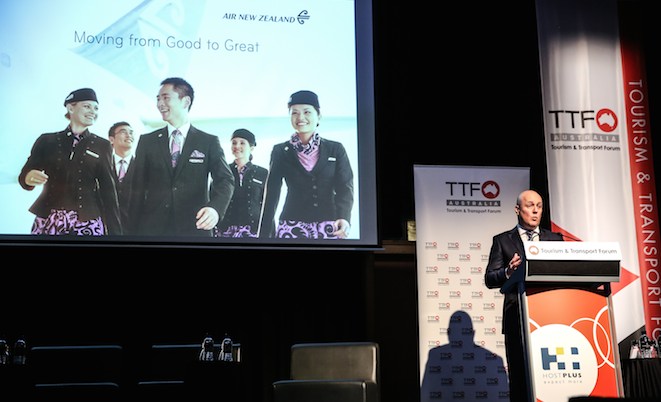
Using geography as an excuse for poor performance is like a child saying the dog ate my homework – it just does not stand up.
So says Air New Zealand chief executive Christopher Luxon, who believes the Kiwi flag carrier’s location is far from a hinderance to operating a profitable airline.
Rather, the Pacific Rim represented a huge opportunity for Air NZ, given the massive rise of the middle class in countries such as China and India.
“I think this whole ‘end of the line’ thing is ‘the dog ate my homework’ excuse sort of in this part of the world really to be brutally honest,” Luxon told the Tourism Transport Forum’s Outlook conference in Sydney on Friday.
“We genuinely sit there, sitting in Australasia, saying ‘there is massive opportunity in that Pacific Rim’.”
Air NZ is forecasting sales growth of between five and seven per cent a year over the next five years alongside a three per cent reduction in costs, Luxon said.
It plans to spend NZ$2 billion taking delivery of 22 new aircraft over the next three years, is building new airport lounges in Sydney and Auckland, as well as developing new markets alongside alliance partners such as Virgin Australia, Cathay Pacific and Singapore Airlines.
The company reported a net profit of $NZ140 million for the six months to December 31 2013, up 40 per cent from the prior corresponding period.
Luxon said Air NZ’s investment in Virgin Australia – the carrier is Virgin’s largest shareholder at 24.46 per cent behind Singapore Airlines (22.17 per cent) and Etihad Airways (21.24 per cent) – was part of being a “Pacific Rim player”.
“We want to have strength and relevance within that region and we want our assets exposed to a portfolio of markets across that region,” he said.
Luxon said the transformation of Virgin under chief executive John Borghetti had delivered a lot more choice in the “large, adjacent and growing” Australian domestic market
“We are very big fans of the strategy.”
Luxon said the alliance between Virgin and Air NZ, which began in 2011, represented about 55 per cent of the trans-Tasman market.










